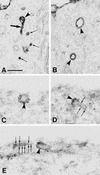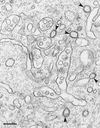Clathrin-coated pits with long, dynamin-wrapped necks upon expression of a clathrin antisense RNA
- PMID: 12682302
- PMCID: PMC154318
- DOI: 10.1073/pnas.0534231100
Clathrin-coated pits with long, dynamin-wrapped necks upon expression of a clathrin antisense RNA
Abstract
To investigate the role of clathrin in coated vesicle formation, a cell line with inducible expression of clathrin heavy chain (CHC) antisense RNA was produced. After 18 h of CHC antisense RNA expression, the internalization of transferrin was inhibited by 90%. Although the amount of CHC was reduced by only 10%, the frequency of clathrin-coated pits at the cell surface increased by a factor of 3-5, and clathrin-coated structures also accumulated on a pleiomorphic, multivesicular, endosomal compartment. Remarkably, the coated pits were connected to the cell surface by long, tubular necks wrapped by dynamin rings, and the level of dynamin in the CHC antisense RNA-expressing cells was up-regulated 10-fold. In contrast, the amount of several other proteins associated with clathrin coat formation was unaffected. Thus, this study demonstrates that CHC antisense RNA causes accumulation of clathrin-coated pits with dynamin rings around the neck in intact cells not transfected with dynamin mutants, suggesting the existence of a previously uncharacterized functional interplay between clathrin and dynamin.
Figures





Comment in
-
Does clathrin pull the fission trigger?Proc Natl Acad Sci U S A. 2003 Apr 29;100(9):4981-3. doi: 10.1073/pnas.0930650100. Epub 2003 Apr 18. Proc Natl Acad Sci U S A. 2003. PMID: 12704235 Free PMC article. No abstract available.
Similar articles
-
Efficient endosome-to-Golgi transport of Shiga toxin is dependent on dynamin and clathrin.J Cell Sci. 2004 May 1;117(Pt 11):2321-31. doi: 10.1242/jcs.01081. J Cell Sci. 2004. PMID: 15126632
-
Dynamin-dependent transferrin receptor recycling by endosome-derived clathrin-coated vesicles.Mol Biol Cell. 2002 Jan;13(1):169-82. doi: 10.1091/mbc.01-07-0380. Mol Biol Cell. 2002. PMID: 11809831 Free PMC article.
-
Dynamin- and clathrin-dependent endocytic pathway in unicellular eukaryote Paramecium.Biochem Cell Biol. 2004 Oct;82(5):547-58. doi: 10.1139/o04-098. Biochem Cell Biol. 2004. PMID: 15499383
-
Understanding living clathrin-coated pits.Traffic. 2004 May;5(5):327-37. doi: 10.1111/j.1398-9219.2004.00187.x. Traffic. 2004. PMID: 15086782 Review.
-
Cargo recognition during clathrin-mediated endocytosis: a team effort.Curr Opin Cell Biol. 2004 Aug;16(4):392-9. doi: 10.1016/j.ceb.2004.06.001. Curr Opin Cell Biol. 2004. PMID: 15261671 Review.
Cited by
-
Canonical interaction of cyclin G associated kinase with adaptor protein 1 regulates lysosomal enzyme sorting.Mol Biol Cell. 2007 Aug;18(8):2991-3001. doi: 10.1091/mbc.e06-12-1162. Epub 2007 May 30. Mol Biol Cell. 2007. PMID: 17538018 Free PMC article.
-
Cortical recruitment and nuclear-cytoplasmic shuttling of Scd5p, a protein phosphatase-1-targeting protein involved in actin organization and endocytosis.Mol Biol Cell. 2006 Jan;17(1):251-62. doi: 10.1091/mbc.e05-10-0936. Epub 2005 Oct 26. Mol Biol Cell. 2006. PMID: 16251346 Free PMC article.
-
Visualizing the effect of dynamin inhibition on annular gap vesicle formation and fission.J Cell Sci. 2013 Jun 15;126(Pt 12):2607-16. doi: 10.1242/jcs.116269. Epub 2013 Apr 16. J Cell Sci. 2013. PMID: 23591819 Free PMC article.
-
The trans-Golgi network accessory protein p56 promotes long-range movement of GGA/clathrin-containing transport carriers and lysosomal enzyme sorting.Mol Biol Cell. 2007 Sep;18(9):3486-501. doi: 10.1091/mbc.e07-02-0190. Epub 2007 Jun 27. Mol Biol Cell. 2007. PMID: 17596511 Free PMC article.
-
Endocytosis of the anthrax toxin is mediated by clathrin, actin and unconventional adaptors.PLoS Pathog. 2010 Mar 5;6(3):e1000792. doi: 10.1371/journal.ppat.1000792. PLoS Pathog. 2010. PMID: 20221438 Free PMC article.
References
Publication types
MeSH terms
Substances
LinkOut - more resources
Full Text Sources
Other Literature Sources

